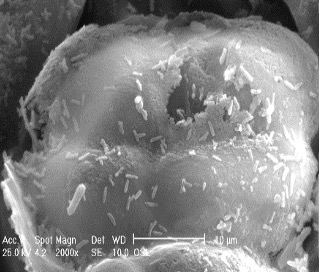The ‘small world’ inside plants – an introduction to plant microbiomes

by Suni Mathew
All multicellular organisms harbour micro-organisms. It is now well-known that the human body is a reservoir of microbes and is found in numerous quantities on the skin or inside the gut. Research on human microbiota has revealed how important it is in providing immunity against diseases, improving gut health as well as maintaining mental health. Likewise, plants harbor microbes on the surfaces of leaves, stems or roots and inside their tissues. Our lab focuses on plant microbiota. They are proven to provide disease resistance, tolerance to abiotic stresses such as drought, cold or salinity and improved nutrient acquisition. In short, they maintain plant health and fitness.
Any multicellular organism – human, animal or plant – is thus an assemblage of different species i.e., the eukaryotic host and associated extra- and intra-cellular micro-organisms including bacteria, fungi and viruses. Thus, the host and its microbial community together as a co-evolving ecological unit is called the holobiont. The genetic constitution of a holobiont is therefore constituted by genes of the host as well as the microbes associated with it, called hologenome. The host genetic constitution is called genome, while the genetic constitution of microbial cells is called the microbiome. In fact, the microbiome genes are 10 to 100-fold times higher than host genes! Another noteworthy aspect is that the microbiome is heritable, and it is passed onto the host offspring.
We are trying to understand the importance of microbial community in plants. This gives insight into the functions provided by these microbes to the plants. It is also important to learn from an ecological point of view, how external stimuli such as climate change or human-driven pressure such as agricultural fertilizers influence their microbiome, thereby endangering plant health.
Microbial communities residing on the plant surfaces are called epiphytes while those inside the tissues are called endophytes. The epiphytes are readily affected by external factors such as wind, temperature, light and rain. The community structure is very dynamic. The endophytes are protected by the host tissues by sudden changes and any drastic change in the microbial community may be due to continuous external stimuli. Moreover, they are very specific to the host plant and are influenced for instance, by chemical composition or pH changes. Hence, we focus on the structure and function of endophytic community, how it affects host plant growth and well-being and what factors determine their assembly.
The traditional method, a few decades ago to study endophytic microbes included extracting plant fluids and plating them on microbial culture media. Microbes were identified and characterized morphologically. However, most microbes never survived outside their host environment in laboratory conditions and many important key players were missed out. With advances in genome sequencing methods, this shortcoming has been greatly solved and vast numbers of previously unculturable microbes have now been identified. This was possible by identifying the microbes inside out, i.e., the microbes are identified and characterized by checking their genetic sequence. In other words, the microbiome is identified first and then mapped to identify their owners, the microbes. We will look into the principle and procedure of isolating and identifying endophytic microbes using next generation sequencing techniques.
Term-bank
- Micro-organism: microscopic uni- or multi-cellular organisms such as bacteria, fungi, protists.
- Microbes: micro-organisms living in a particular environment. Often used as a synonym for micro-organism.
- Microbiota: Plural for microbes. Also refers to a microbial community consisting of different microbial members; microbiota with different species of bacteria or microbiota with different species of bacteria and fungi.
- Holobiont: A living, reproducing entity constituting a eukaryotic host (e.g., plant) and its associated microbial communities.
- Hologenome: Genetic constitution of holobiont i.e., collection of host genes and genes of microbial communities.
- Microbiome: collection of genes of members of microbiota or a microbial community.